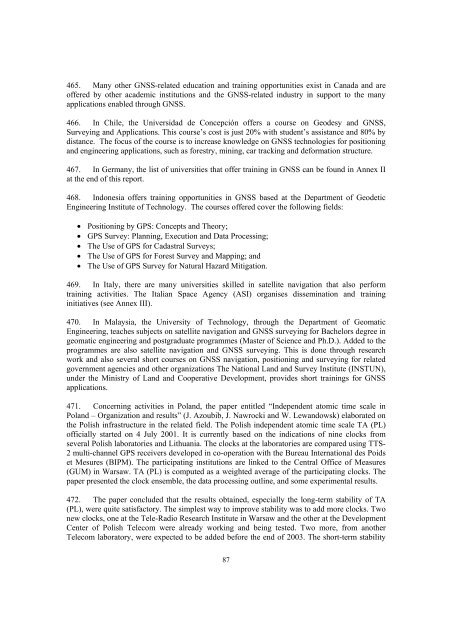report of the action team on global navigation satellite systems (gnss)
report of the action team on global navigation satellite systems (gnss)
report of the action team on global navigation satellite systems (gnss)
Create successful ePaper yourself
Turn your PDF publications into a flip-book with our unique Google optimized e-Paper software.
465. Many o<str<strong>on</strong>g>the</str<strong>on</strong>g>r GNSS-related educati<strong>on</strong> and training opportunities exist in Canada and are<str<strong>on</strong>g>of</str<strong>on</strong>g>fered by o<str<strong>on</strong>g>the</str<strong>on</strong>g>r academic instituti<strong>on</strong>s and <str<strong>on</strong>g>the</str<strong>on</strong>g> GNSS-related industry in support to <str<strong>on</strong>g>the</str<strong>on</strong>g> manyapplicati<strong>on</strong>s enabled through GNSS.466. In Chile, <str<strong>on</strong>g>the</str<strong>on</strong>g> Universidad de C<strong>on</strong>cepción <str<strong>on</strong>g>of</str<strong>on</strong>g>fers a course <strong>on</strong> Geodesy and GNSS,Surveying and Applicati<strong>on</strong>s. This course’s cost is just 20% with student’s assistance and 80% bydistance. The focus <str<strong>on</strong>g>of</str<strong>on</strong>g> <str<strong>on</strong>g>the</str<strong>on</strong>g> course is to increase knowledge <strong>on</strong> GNSS technologies for positi<strong>on</strong>ingand engineering applicati<strong>on</strong>s, such as forestry, mining, car tracking and deformati<strong>on</strong> structure.467. In Germany, <str<strong>on</strong>g>the</str<strong>on</strong>g> list <str<strong>on</strong>g>of</str<strong>on</strong>g> universities that <str<strong>on</strong>g>of</str<strong>on</strong>g>fer training in GNSS can be found in Annex IIat <str<strong>on</strong>g>the</str<strong>on</strong>g> end <str<strong>on</strong>g>of</str<strong>on</strong>g> this <str<strong>on</strong>g>report</str<strong>on</strong>g>.468. Ind<strong>on</strong>esia <str<strong>on</strong>g>of</str<strong>on</strong>g>fers training opportunities in GNSS based at <str<strong>on</strong>g>the</str<strong>on</strong>g> Department <str<strong>on</strong>g>of</str<strong>on</strong>g> GeodeticEngineering Institute <str<strong>on</strong>g>of</str<strong>on</strong>g> Technology. The courses <str<strong>on</strong>g>of</str<strong>on</strong>g>fered cover <str<strong>on</strong>g>the</str<strong>on</strong>g> following fields:• Positi<strong>on</strong>ing by GPS: C<strong>on</strong>cepts and Theory;• GPS Survey: Planning, Executi<strong>on</strong> and Data Processing;• The Use <str<strong>on</strong>g>of</str<strong>on</strong>g> GPS for Cadastral Surveys;• The Use <str<strong>on</strong>g>of</str<strong>on</strong>g> GPS for Forest Survey and Mapping; and• The Use <str<strong>on</strong>g>of</str<strong>on</strong>g> GPS Survey for Natural Hazard Mitigati<strong>on</strong>.469. In Italy, <str<strong>on</strong>g>the</str<strong>on</strong>g>re are many universities skilled in <strong>satellite</strong> navigati<strong>on</strong> that also performtraining activities. The Italian Space Agency (ASI) organises disseminati<strong>on</strong> and traininginitiatives (see Annex III).470. In Malaysia, <str<strong>on</strong>g>the</str<strong>on</strong>g> University <str<strong>on</strong>g>of</str<strong>on</strong>g> Technology, through <str<strong>on</strong>g>the</str<strong>on</strong>g> Department <str<strong>on</strong>g>of</str<strong>on</strong>g> GeomaticEngineering, teaches subjects <strong>on</strong> <strong>satellite</strong> navigati<strong>on</strong> and GNSS surveying for Bachelors degree ingeomatic engineering and postgraduate programmes (Master <str<strong>on</strong>g>of</str<strong>on</strong>g> Science and Ph.D.). Added to <str<strong>on</strong>g>the</str<strong>on</strong>g>programmes are also <strong>satellite</strong> navigati<strong>on</strong> and GNSS surveying. This is d<strong>on</strong>e through researchwork and also several short courses <strong>on</strong> GNSS navigati<strong>on</strong>, positi<strong>on</strong>ing and surveying for relatedgovernment agencies and o<str<strong>on</strong>g>the</str<strong>on</strong>g>r organizati<strong>on</strong>s The Nati<strong>on</strong>al Land and Survey Institute (INSTUN),under <str<strong>on</strong>g>the</str<strong>on</strong>g> Ministry <str<strong>on</strong>g>of</str<strong>on</strong>g> Land and Cooperative Development, provides short trainings for GNSSapplicati<strong>on</strong>s.471. C<strong>on</strong>cerning activities in Poland, <str<strong>on</strong>g>the</str<strong>on</strong>g> paper entitled “Independent atomic time scale inPoland – Organizati<strong>on</strong> and results” (J. Azoubib, J. Nawrocki and W. Lewandowsk) elaborated <strong>on</strong><str<strong>on</strong>g>the</str<strong>on</strong>g> Polish infrastructure in <str<strong>on</strong>g>the</str<strong>on</strong>g> related field. The Polish independent atomic time scale TA (PL)<str<strong>on</strong>g>of</str<strong>on</strong>g>ficially started <strong>on</strong> 4 July 2001. It is currently based <strong>on</strong> <str<strong>on</strong>g>the</str<strong>on</strong>g> indicati<strong>on</strong>s <str<strong>on</strong>g>of</str<strong>on</strong>g> nine clocks fromseveral Polish laboratories and Lithuania. The clocks at <str<strong>on</strong>g>the</str<strong>on</strong>g> laboratories are compared using TTS-2 multi-channel GPS receivers developed in co-operati<strong>on</strong> with <str<strong>on</strong>g>the</str<strong>on</strong>g> Bureau Internati<strong>on</strong>al des Poidset Mesures (BIPM). The participating instituti<strong>on</strong>s are linked to <str<strong>on</strong>g>the</str<strong>on</strong>g> Central Office <str<strong>on</strong>g>of</str<strong>on</strong>g> Measures(GUM) in Warsaw. TA (PL) is computed as a weighted average <str<strong>on</strong>g>of</str<strong>on</strong>g> <str<strong>on</strong>g>the</str<strong>on</strong>g> participating clocks. Thepaper presented <str<strong>on</strong>g>the</str<strong>on</strong>g> clock ensemble, <str<strong>on</strong>g>the</str<strong>on</strong>g> data processing outline, and some experimental results.472. The paper c<strong>on</strong>cluded that <str<strong>on</strong>g>the</str<strong>on</strong>g> results obtained, especially <str<strong>on</strong>g>the</str<strong>on</strong>g> l<strong>on</strong>g-term stability <str<strong>on</strong>g>of</str<strong>on</strong>g> TA(PL), were quite satisfactory. The simplest way to improve stability was to add more clocks. Tw<strong>on</strong>ew clocks, <strong>on</strong>e at <str<strong>on</strong>g>the</str<strong>on</strong>g> Tele-Radio Research Institute in Warsaw and <str<strong>on</strong>g>the</str<strong>on</strong>g> o<str<strong>on</strong>g>the</str<strong>on</strong>g>r at <str<strong>on</strong>g>the</str<strong>on</strong>g> DevelopmentCenter <str<strong>on</strong>g>of</str<strong>on</strong>g> Polish Telecom were already working and being tested. Two more, from ano<str<strong>on</strong>g>the</str<strong>on</strong>g>rTelecom laboratory, were expected to be added before <str<strong>on</strong>g>the</str<strong>on</strong>g> end <str<strong>on</strong>g>of</str<strong>on</strong>g> 2003. The short-term stability87
















